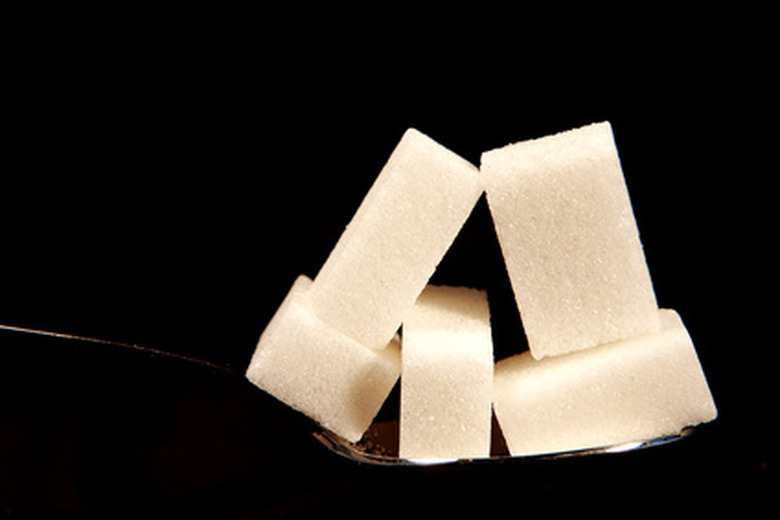Where Does Glucose Reabsorption Occur?
When the kidneys filter blood to remove waste products, they initially pass the blood through a membrane that removes large molecules like proteins but permits waste products, salts, water molecules, amino acids and sugars like glucose to pass through. In order to ensure that valuable molecules like glucose and amino acids aren't excreted together with the waste products, the kidney must reabsorb them. Glucose reabsorption is a process that takes place in the proximal tubule.
Filtering Blood in the Nephrons
Filtering Blood in the Nephrons
Blood flows into the kidney through the renal artery, which branches and subdivides into smaller vessels to supply blood to the nephrons. The nephrons are the functional units of the kidney that carry out the actual filtration and reabsorption; there are approximately one million of them in each adult human kidney. Each nephron is comprised of a network of capillaries where filtration and reabsorption take place.
Glucose Filtration in the Glomerulus
Glucose Filtration in the Glomerulus
The blood flows through a ball of capillaries called the glomerulus. Here the blood pressure causes water, dissolved salts and small molecules like waste products, amino acids and glucose to leak through the capillaries' walls into a structure called Bowman's capsule, which surrounds the glomerulus. This initial step removes waste products from the blood while preventing the loss of cells like red blood cells or proteins, but it also removes valuable molecules like glucose from the bloodstream. Removal of necessary solutes prompts the next step in the filtration process: reabsorption.
Glucose Reabsorption in the Kidneys
Glucose Reabsorption in the Kidneys
The tubular portion of the nephron consists of the proximal tubule, the loop of Henle and the distal tubule. Distal tubules and proximal tubules perform opposing functions. While the proximal tubule reabsorbs solutes into the blood supply, the distal tubule secretes waste solutes that will be excreted in urine. Glucose reabsorption takes place in the proximal tubule of the nephron, a tube leading out of Bowman's capsule. The cells that line the proximal tubule recapture valuable molecules, including glucose. The mechanism of reabsorption is different for different molecules and solutes. For glucose there are two processes involved: the process whereby glucose is reabsorbed across the apical membrane of the cell, meaning the membrane of the cell that faces out onto the proximal tubule, and then the mechanism whereby the glucose is shunted across the opposite membrane of the cell into the bloodstream.
Sodium-Dependent Glucose Cotransporters
Sodium-Dependent Glucose Cotransporters
Embedded in the apical membrane of the cells lining the proximal tubule are proteins that act like tiny molecular pumps to drive sodium ions out of the cell and potassium ions in, expending stored cellular energy in the process. This pumping action ensures that the concentration of sodium ions is much higher in the proximal tubule than in the cell, like pumping water to a storage tank atop a hill so it can do work as it flows back down.
Solutes dissolved in water naturally tend to diffuse from areas of high to low concentration, which causes the sodium ions to flow back into the cell. The cell takes advantage of this concentration gradient using a protein called the sodium dependent glucose cotransporter 2 (SGLT2), which couples the cross-membrane transport of a sodium ion to the transport of a glucose molecule. Essentially, the SGLT2 is a little like a glucose pump powered by the sodium ions trying to get back into the cell.
Glucose Transporter: GLUT2
Glucose Transporter: GLUT2
Once the glucose is inside the cell, returning it to the bloodstream is a simple process. Proteins called glucose transporters or GLUT2s are embedded in the cellular membrane adjacent to the bloodstream and ferry the glucose across the membrane back into the blood. Usually the glucose is more concentrated inside the cell, so the cell doesn't need to expend any energy for this last stage. The GLUT2 plays a largely passive role like a revolving door that allows the outbound glucose molecules to slip through. Not all of the glucose can be reabsorbed in people with hyperglycemia, or high blood sugar. The excess glucose must be secreted by the distal tubule and passed in urine.
Cite This Article
MLA
Brennan, John. "Where Does Glucose Reabsorption Occur?" sciencing.com, https://www.sciencing.com/glucose-reabsorption-occur-6648505/. 27 November 2018.
APA
Brennan, John. (2018, November 27). Where Does Glucose Reabsorption Occur?. sciencing.com. Retrieved from https://www.sciencing.com/glucose-reabsorption-occur-6648505/
Chicago
Brennan, John. Where Does Glucose Reabsorption Occur? last modified March 24, 2022. https://www.sciencing.com/glucose-reabsorption-occur-6648505/
